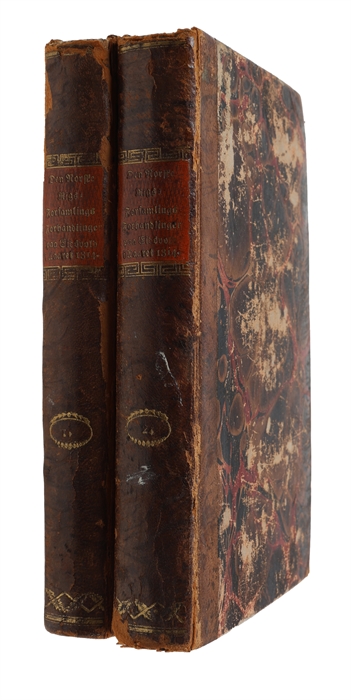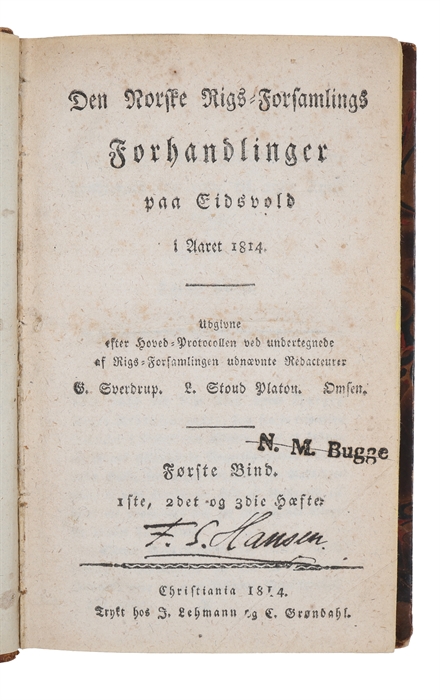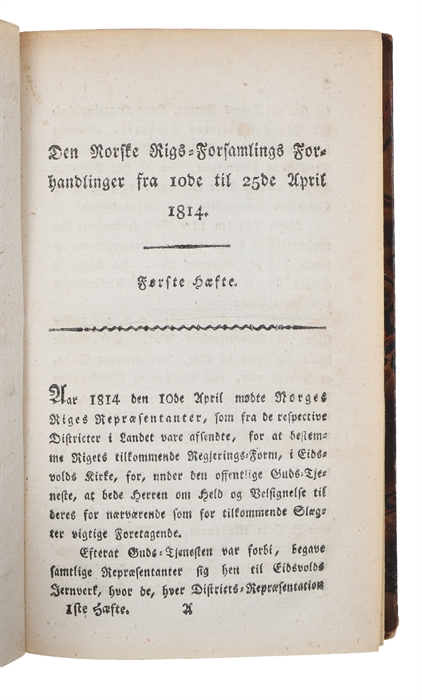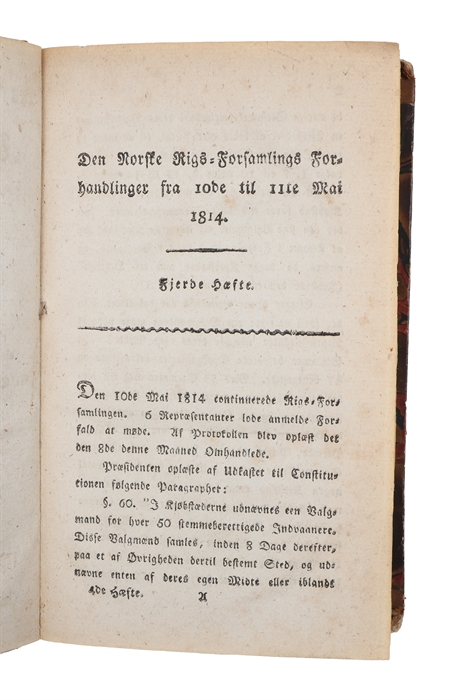THE NORWEGIAN CONSTITUENT ASSEMBLY OF EIDSVOLL - WHEN NORWAY BECAME AN INDEPENDENT STATE
SVERDRUP, GEORG et al.
Den Norske Rigs=Forsamlings Forhandlinger paa Eidsvold i Aaret 1814. Udgivne efter Hoved=Protocollen ved undertegnede af Rigs=Forsamlingen udnævnte Redacteurer G. Sverdrup, L. Stoud Platou, Omsen. 1.-6. Hæfte (All published)
Christiania, Lehmann & Grøndahl, 1814.
8vo. Six parts uniformly bound in two contemporary half calf bindings with red leather title-label and gilt lettering to spines. Previous owner's names to front free end-papers and title-pages. Previous owner's stamp (N. M. Bugge) to title-pages. Wear to extremities, boards with scratches. Leaf A1 in the fifth part with reapir in inner margin, slightly touching text, otherwise internally very nice and clean. Part 1-2: (2), 67, (2), 104, 104 pp. Part 3-6: (2),108, (2), 107, (2), 128 pp.
Scarce first edition of all the minutes from Norway's Constitutional Assembly, immediately leading to the first Norwegian Constitution of May 17, 1814. It was adopted on 16 May and signed on 17 May 1814 by the Norwegian Constituent Assembly at Eidsvoll. The latter date is the National Day of Norway. “On 10 April 1814 a national assembly consisting of 112 elected representatives met together at Eidsvoll, convened by the Regent of Norway, Christian Frederik. Their task was to draw up a new constitution, since Norway had become an independent kingdom and no longer part of Denmark. On April 12, a special committee led by Christian Falsen was established to draft the new constitution. The committee presented its proposal outlining the core principles to the assembly just four days later, where the majority of provisions were widely accepted. “However, the Swedish Crown Prince, Carl Johan, refused to accept Norway’s independence since under the Treaty of Kiel Denmark had ceded Norway to Sweden. On 29 July Swedish troops marched into Norway and rapidly put down the Norwegian resistance. On 14 August both parties signed the Convention of Moss, under the terms of which Christian Frederik had to surrender the Norwegian throne. The King of Sweden agreed to accept the Eidsvoll constitution, amended only to take account of the union with Sweden. On 4 November, after the Norwegian national assembly had adopted the amended Constitution, Carl XIII of Sweden became Carl II of Norway.” (Ibid.). The constitution was a very radical one for its time. Instead of being concentrated in the person of an autocratic king, power was divided between the king, the courts and a popularly elected national assembly. The king had the executive power and the national assembly the legislative power. Almost half the male population had the right to vote.
It is the fourth oldest written single-document national constitution in Europe after the Constitution of Poland, the French constitution of 1791, and the Spanish Constitution of 1812. The document is also the second oldest working national constitution in the world, after the Constitution of the United States.
It soon became obvious that the assembly was divided: one party favoured union with Sweden and the other favoured independence. The advocates of union, led by Count Wedel Jarlsberg, felt that it would not be possible for Norway to retain its independence without the support of the major European powers. They argued that it would be better to negotiate with Sweden on the best possible conditions for union.
The independence party supported Christian Frederik, who maintained that Norway should be an independent nation. It was this party, led by Christian Falsen and Professor Georg Sverderup, that held the majority in the assembly.” (The Royal House of Norway)
The constitution defined Norway as a free and independent. It assigned executive power to the King, legislative authority to a popularly elected national assembly and judicial power to independent courts. Freedom of religion and freedom of the press were also included.
On May 17, 1814, the Constitution was formally adopted, and the assembly unanimously elected Christian Frederik as Norway’s first king in nearly 500 years.
Order-nr.: 61660





